This post contains affiliate links
Turmeric is a powerful antioxidant and anti-inflammatory, so of course we’re throwing it into our kombucha for a healthier home brew! Here’s how to make Turmeric Kombucha.
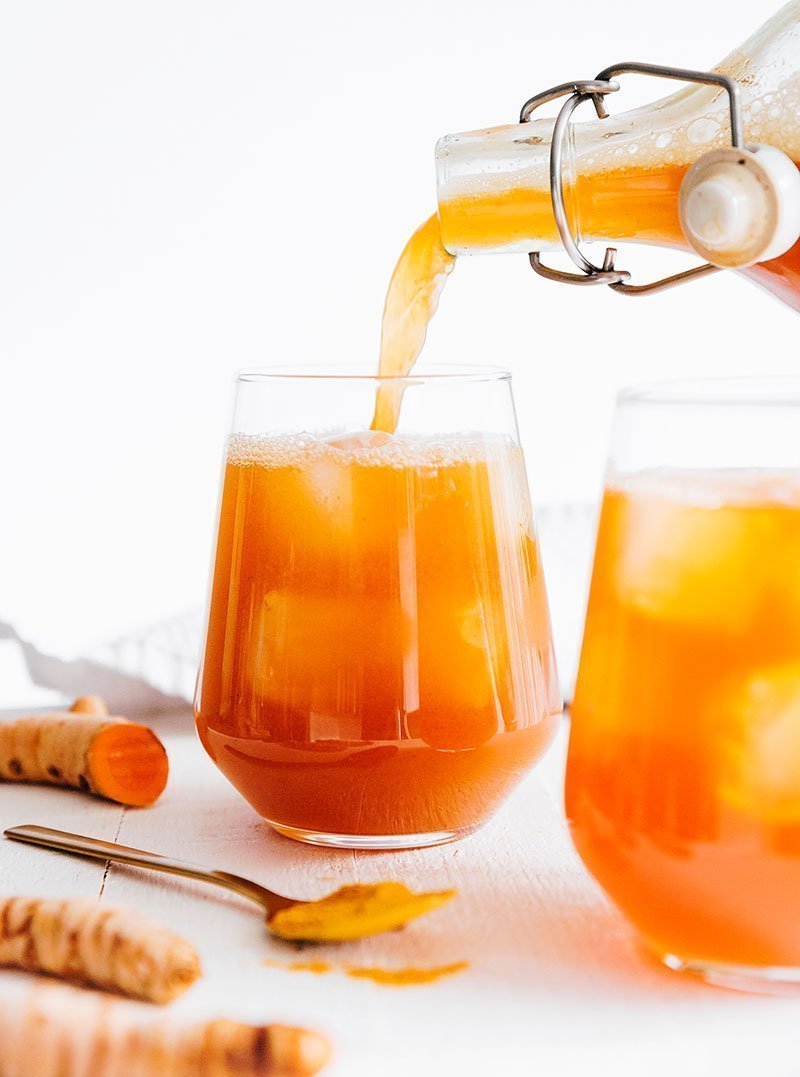
With the rise in popularity of golden milk, it’s about time we make golden…kombucha! For the uninitiated, golden milk is a healthy blend of warm milk and ground turmeric.
In addition to being packed with cozy flavor, golden milk is incredibly healthy, due in large part to the curcumin found in turmeric. Turmeric has been used in Ayurvedic medicine for thousands of years, for everything from digestive issues to joint pain. More recent studies have found that it contains properties that make it anti-inflammatory, antimicrobial, and antioxidant.
So if you’re looking to supercharge your kombucha, here’s how to level it up with turmeric!
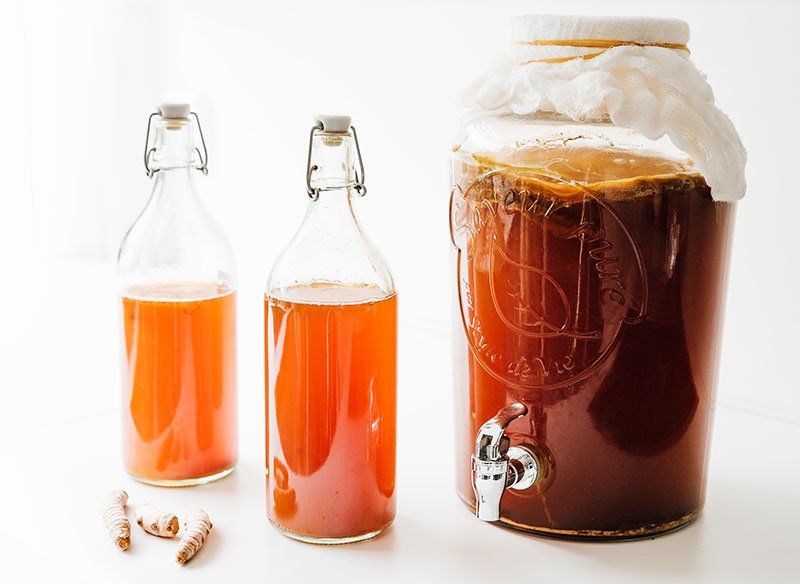
There are two main fermentation phases when making homemade kombucha:
- First Fermentation: This is when you transform sweet tea into tart and delicious kombucha (see our guide to homemade kombucha here).
- Second Fermentation: This is when you carbonate the kombucha by adding flavor and sugars (like honey) and bottling it.
In order to make this Turmeric Kombucha, you will need to have completed the first fermentation and have some kombucha that’s ready to be carbonated!
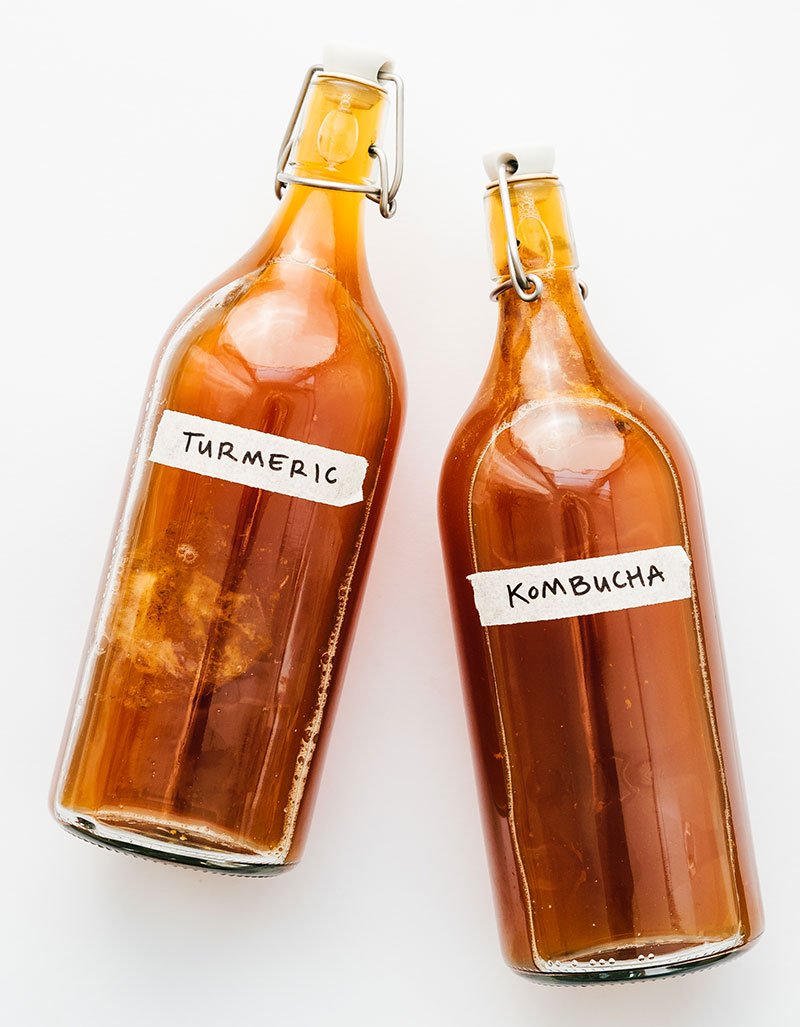
Turmeric Kombucha Ingredients
Turmeric can have a bitter, slightly musty flavor when used in excess or on its own. For this reason, I like to pair it with some sidekick flavors to make it truly shine! Here’s what you’ll need:
- Kombucha: You have brewed your kombucha in the first fermentation and are ready to flavor it (first fermentation instructions here).
- Ground Turmeric: We use ground turmeric, which is easier to find in most groceries. If you can get your hands on fresh turmeric, that’s great in kombucha too!
- Ground Cinnamon: I love to play off the cozy flavors of turmeric by adding a bit of cinnamon. For a zingier flavor, you could replace the ground cinnamon with ground or fresh ginger.
- Honey: Just a touch of honey will provide sugar for bacteria and yeast to feed on, creating carbonation and fizz. You can replace the honey with carrot juice for an even more healthy, orange elixir!
How to make turmeric kombucha
Making your own Turmeric Kombucha is ultra simple. The process goes something like this:
- Bottle: Evenly distribute turmeric, cinnamon, and honey into fermentation bottles. Pour in kombucha, leaving 1 to 2 inches free at the top
- Ferment: For 3 to 10 days, until it reaches the carbonation level you like.
- Enjoy: Chill in the fridge before serving, optionally straining out the fruit and ginger fibers.
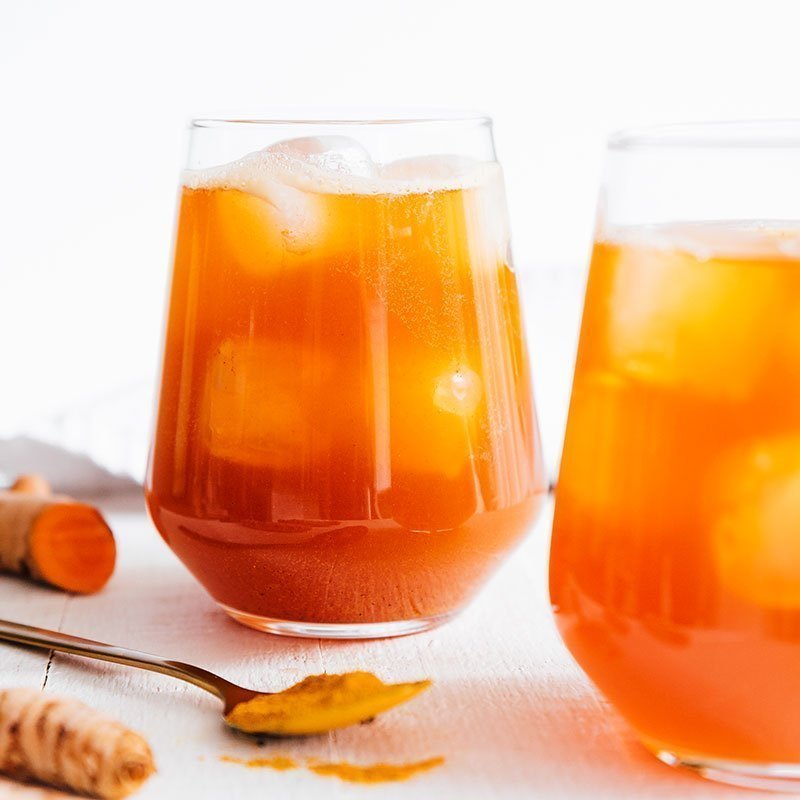
You may also like these flavors

Turmeric Kombucha
Ingredients
- 1/2 gallon kombucha from a first fermentation this is not store bought kombucha, 1.9 L
- 1/2 tsp ground turmeric can sub 1 to 2 tsp fresh grated turmeric
- 1/4 tsp ground cinnamon can sub 1 to 2 tsp fresh grated ginger
- 2 tsp honey can sub 1/4 cup carrot juice
Instructions
- Bottle: Evenly turmeric, cinnamon, and honey into fermentation bottles*. Pour in first fermentation kombucha, leaving 1 to 2 inches free at the top.
- Ferment: Place in a dark, room temperature area for 3 to 10 days, until it reaches the carbonation level you like. This process will go faster in warmer climates, and slower in cooler climates.
- Enjoy: Chill in the fridge before serving, optionally straining out the fibers. Can be stored in the fridge, tightly sealed, for several weeks.
Notes
Recommended Products
As an Amazon Associate and member of other affiliate programs, I earn from qualifying purchases.
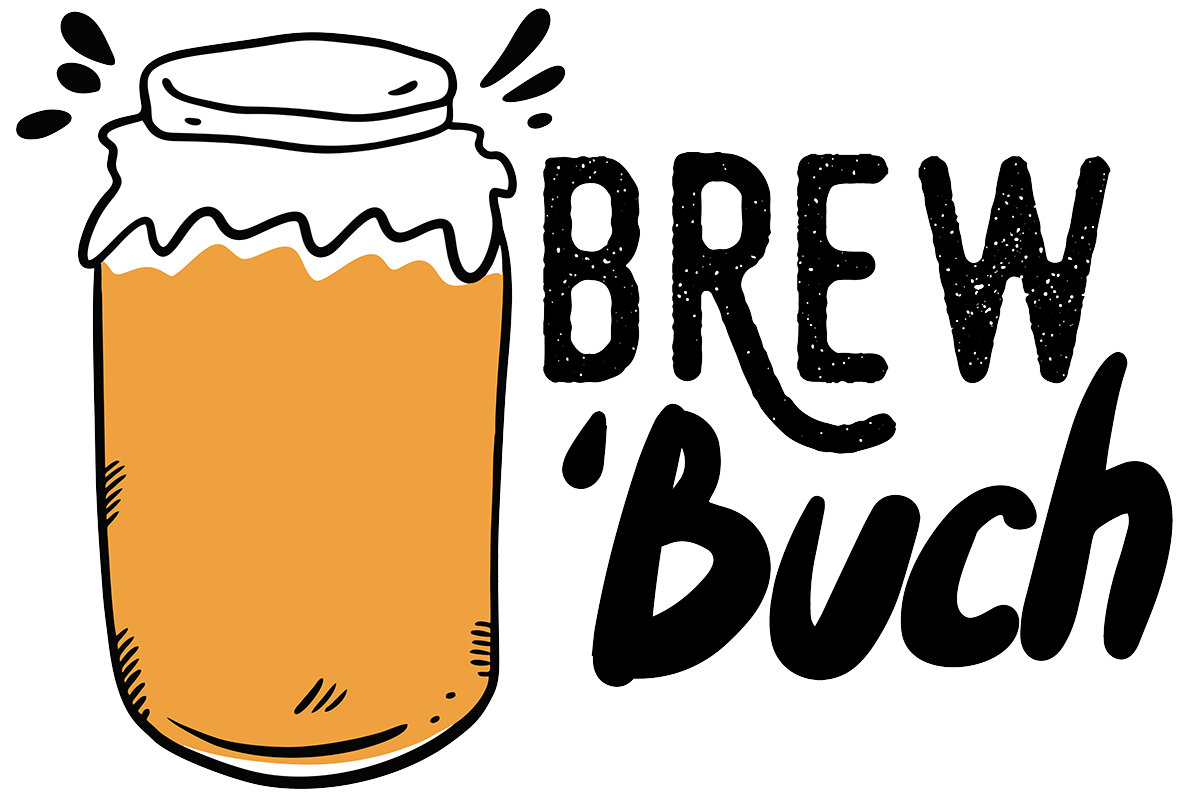
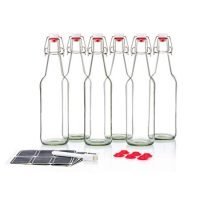
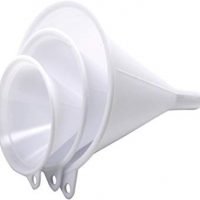
Hi Sarah,
What is a difference if I use the cold pressed turmeric juice for the turmeric Kombucha?
My friends asked for stronger taste of turmeric and told me to use the turmeric juice instead of grates one. I tried it and I feel like the kombucha has less carbonation. I read someone share that the turmeric oil will affect on the yeast leading to decrease the carbonation.
If you have experience on this, please help me figure out the best recipe for this gorgeous drink.
Thank you
Hi Tuyen! I don’t have experience using the juice, but I think it would work! You could always add in a teaspoon of sugar to help with carbonation.
Sounds good, thank you for the idea. I love my kombucha & I like golden milk. I look forward to trying it. I had one thought though. Usually with making golden milk you add pepper to facilitate the absorption of the curcumin. So I think I will try adding it when making my batch of ‘buche’.
Hi Sarah,
I think Bjoern has a legitimate question.
I only started brewing a few months ago, but I thought yeast and sugar caused the carbonation, not bacteria. Bacteria needs oxygen and we try to exclude that by using airtight bottles.
How can we notice “bacteria action”? Wouldn’t it be in the form of a SCOBY (pellicle) when a bottle’s seal is not airtight. No air supply for the bacteria, no SCOBY.
Regards, Brigitte
Bacteria is responsible for the flavor! The yeast in the SCOBY eat the sugars in your kombucha, transforming them into ethanol. The bacteria feed on this ethanol, turning it into acidity and giving kombucha its distinctively sour taste. The bacteria also feed on some of the sugar, producing cellulose as a result. This cellulose builds up to form the thick, rubbery SCOBY!
Hi Sarah,
I just discovered your site, looking for inspiration on new ways to flavor my kombucha. Thank you for sharing your knowledge! I don’t want to come across as a wining old man – and maybe my approach is a bit puritan – but I try to avoid any flavoring that potentially could be harmful to the healthy bacteria. Ginger, for example, is one of my favorite tastes but I stopped using it in kombucha since I got aware of its antibacterial qualities. What is your opinion on this?
I haven’t noticed ginger causing there to be less kombucha bacteria action (if there were, it would be less fizzy and flavorful). In fact, ginger seems to stimulate the fermentation and usually makes it even more carbonated!
Hi Sarah,
thanks for all the wonderful recipes. With regard to Tumeric Kombucha my favorite taste is made by Martha from Spain, Kombucha Masters Wageningen, she makes Kombucha with Tumeric and Grapefruit and it tastes amazing !!!
You should try it…
Yvonne
Oh that sounds delicious! Wish I had known about her when I over on that side of the world so I could try her stuff! 😀
Hi Sarah, I am new to your awesome and informative site.
I have been making Kombucha for years and love it.
I would like to substitute grated ginger for organic ground ginger in your recipes what would the ratio be please and do you think that will work well?
I tsp of grated ginger = ??
I do a lot of swapping with my Kombucha with friends and this bartering works so well.
Thank you. ????
Great question, Helen! When I use ground ginger, I do about 2 tsp ginger per 1/2 gallon. Enjoy!